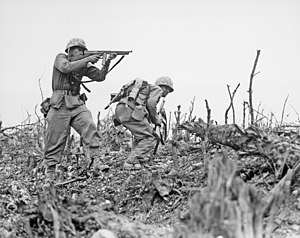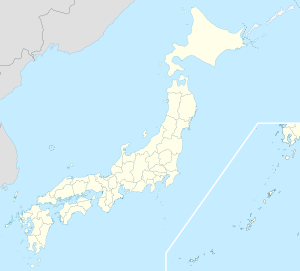| Battle of Okinawa | |||||||
|---|---|---|---|---|---|---|---|
| Part of the Volcano and Ryukyu Islands campaign of the Pacific Theater (World War II) | |||||||
 1st Marine Regiment during fighting at Wana Ridge during the Battle of Okinawa, May 1945 | |||||||
| |||||||
| Belligerents | |||||||
|
Ground forces: Naval forces: |
| ||||||
| Commanders and leaders | |||||||
|
|
| ||||||
| Units involved | |||||||
|
Ground units: Naval units:
|
Ground units:
Naval units: | ||||||
| Strength | |||||||
~183,000 combat troops[4] rising to ~250,000[5]: 567 |
~40,000+ Okinawan conscripts[8] | ||||||
| Casualties and losses | |||||||
|
Materiel: 375 tanks destroyed[18] 13 destroyers sunk 15 amphibious ships sunk 8 other ships sunk 386 ships damaged 763 aircraft lost[5]: 573 [19]: 473 |
Battle & Non-battle casualties: 94,136 soldiers and sailors dead (all causes)[e] 4,037 dead from Yamato task force[21] 7,401 captured (by 30 June)[22][f] Total casualties: ~105,000 to 110,000 Materiel: 1 battleship sunk 1 light cruiser sunk 5 destroyers sunk 9 other warships sunk 1,430 aircraft lost[23] 27 tanks destroyed 743–1,712 artillery pieces, anti-tank guns, mortars and anti-aircraft guns lost[19]: 91–92 | ||||||
| 40,000–150,000 civilians dead[24][25][g] | |||||||
Location within Japan | |||||||
The Battle of Okinawa (Japanese: 沖縄戦, Hepburn: Okinawa-sen), codenamed Operation Iceberg,[27]: 17 was a major battle of the Pacific War fought on the island of Okinawa by United States Army and United States Marine Corps forces against the Imperial Japanese Army.[28][29] The initial invasion of Okinawa on 1 April 1945 was the largest amphibious assault in the Pacific Theater of World War II.[30][31] The Kerama Islands surrounding Okinawa were preemptively captured on 26 March by the 77th Infantry Division. The 82-day battle lasted from 1 April until 22 June 1945. After a long campaign of island hopping, the Allies were planning to use Kadena Air Base on the large island of Okinawa as a base for Operation Downfall, the planned invasion of the Japanese home islands, 340 mi (550 km) away.
The United States created the Tenth Army, a cross-branch force consisting of the U.S. Army 7th, 27th, 77th and 96th Infantry Divisions with the 1st, 2nd, and 6th Marine Divisions, to fight on the island. The Tenth Army was unique in that it had its own Tactical Air Force (joint Army-Marine command) and was supported by combined naval and amphibious forces. Opposing the Allied forces on the ground was the Japanese Thirty-Second Army. The Battle of Okinawa was the single longest sustained carrier campaign of the Second World War.[32]
The battle has been referred to as the "typhoon of steel" in English, known in Japanese as "tetsu no bōfū".[33][34] The nicknames refer to the ferocity of the fighting, the intensity of Japanese kamikaze attacks and the sheer numbers of Allied ships and armored vehicles that assaulted the island. The battle was the bloodiest and fiercest of the Pacific War, with some 50,000 Allied and around 100,000 Japanese casualties,[35][19]: 473–474 also including local Okinawans conscripted into the Japanese Army.[24] According to local authorities, at least 149,425 Okinawan people were killed, died by coerced suicide or went missing.[36]
In the naval operations surrounding the battle, both sides lost considerable numbers of ships and aircraft, including the Japanese battleship Yamato. After the battle, Okinawa provided the victorious Allies a fleet anchorage, troop staging areas, and airfields in proximity to Japan as they planned to invade the Japanese home islands.
- ^ "Ryukus". US Army Center of Military History. Archived from the original on 19 September 2020. Retrieved 28 August 2020.
- ^ 26 March marked the first landing on the Kerama Islands around Okinawa in the Ryukus by the 77th Division.
- ^ a b "The Forgotten Fleet - Warfare History Network". warfarehistorynetwork.com. 2017. Retrieved 26 September 2024.
- ^ Sloan 2007, p. 18
- ^ a b Keegan, John (2005). The Second World War. Penguin. ISBN 978-0143195085.
- ^ "Okinawa naval order of battle". wikipedia. Retrieved 26 September 2024.
- ^ a b "Kamikazes and Okinawa Campaign". United States Naval Institute.org. Retrieved 27 September 2024.
- ^ Hastings 2008, p. 370
- ^ "The Second World Wars: How the First Global Conflict Was Fought and Won" p. 302
- ^ "Okinawa: The Costs of Victory in the Last Battle". The National WWII Museum. 7 July 2022. Retrieved 23 June 2023.
- ^ Army Battle Casualties and Nonbattle Deaths in World War II. Final Report, 7 December 1941-31 December 1946 p. 95 Retrieved 2/1/2024
- ^ Tenth Army After Action Report, Ryukyus, vol. 1 9-IV-1. Retrieved 2/1/2024
- ^ History of the Medical Department in World War II, vol. III Appendix Table 14, see "Bombing and Landing on Okinawa." Retrieved 2/1/2024
- ^ Springer, "Inferno: The Epic Life and Death Struggle of the USS Franklin in World War II p. 317. Retrieved 2/1/2024
- ^ Frank, "Downfall" p. 402
- ^ Frank and Shaw, "History of U.S. Marine Corps Operations in World War II, Appendix M. Retrieved 2/1/2024
- ^ Frank 1999, p. 71.
- ^ "Survey of Allied tank casualties in World War II" Archived 17 July 2019 at the Wayback Machine, Technical Memorandum ORO-T-117, Department of the Army, Washington D.C.,Table 1.
- ^ a b c
 This article incorporates text from this source, which is in the public domain: Appleman, Roy; Burns, James; Gugeler, Russel; Stevens, John (1948). Okinawa: The Last Battle. United States Army Center of Military History. ISBN 1410222063. Archived from the original on 8 November 2010. Retrieved 14 June 2010.
This article incorporates text from this source, which is in the public domain: Appleman, Roy; Burns, James; Gugeler, Russel; Stevens, John (1948). Okinawa: The Last Battle. United States Army Center of Military History. ISBN 1410222063. Archived from the original on 8 November 2010. Retrieved 14 June 2010.
- ^ Hirofumi Hayashi, "Okinawa-sen to minshu" (Japanese). p. 5. Retrieved 2/1/2024
- ^ Abe 1995, Tokko Yamato Kantai.
- ^ Appleman p. 489
- ^ Giangreco, D. (2009). Hell to Pay Operation Downfall and the Invasion of Japan, 1945–47. Naval Institute Press. p. 91. ISBN 978-1591143161.
- ^ a b Cite error: The named reference
mcgwas invoked but never defined (see the help page). - ^ "11: Battle of Okinawa". Nisei.hawaii.edu. 1 April 1945. Archived from the original on 2 September 2016. Retrieved 19 July 2022.
- ^ Kyle Ikeda, "Unspoken Memory and Vicarious Trauma" p. 12 Retrieved 2/1/2024
- ^
 This article incorporates text from this source, which is in the public domain: Nichols, Charles; Shaw, Henry (1955). Okinawa: Victory in the Pacific (PDF). Government Printing Office. ASIN B00071UAT8. Archived (PDF) from the original on 24 March 2021. Retrieved 18 January 2021.
This article incorporates text from this source, which is in the public domain: Nichols, Charles; Shaw, Henry (1955). Okinawa: Victory in the Pacific (PDF). Government Printing Office. ASIN B00071UAT8. Archived (PDF) from the original on 24 March 2021. Retrieved 18 January 2021.
- ^ Feifer 2001 pp. xi, 99–106
- ^ "Okinawa: The Costs of Victory in the Last Battle". The National WWII Museum | New Orleans. 7 July 2022. Retrieved 21 February 2024.
- ^ "The United States Navy assembled an unprecedented armada in March and April 1945". Militaryhistoryonline.com. Archived from the original on 16 December 2018. Retrieved 6 May 2012.
- ^ "The American invasion of Okinawa was the largest amphibious invasion of all time". Historynet.com. Archived from the original on 28 March 2008. Retrieved 6 May 2012.
- ^ Wheelan, Joseph (2020). Bloody Okinawa: The Last Great Battle of World War II (1st ed.). New York: Hachette Books. p. 343. ISBN 978-0-306-90320-5.
- ^ "Okinawa: The Typhoon of Steel". American Veterans Center. 1 April 1945. Archived from the original on 3 May 2012. Retrieved 12 October 2013.
- ^ At 60th anniversary, Battle of Okinawa survivors recall 'Typhoon of Steel' – News – Stripes Archived 5 April 2020 at the Wayback Machine, Allen, David; Stars and Stripes; 1 April 2005.
- ^ Huber, Thomas (May 1990). "Japan's battle of Okinawa, April–June 1945". Combined Arms Research Library. Archived from the original on 16 October 2004.
- ^ Cite error: The named reference
Prefecturewas invoked but never defined (see the help page).
Cite error: There are <ref group=lower-alpha> tags or {{efn}} templates on this page, but the references will not show without a {{reflist|group=lower-alpha}} template or {{notelist}} template (see the help page).

